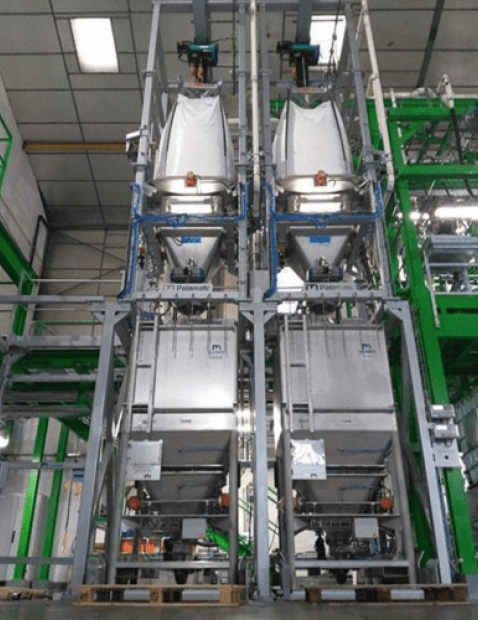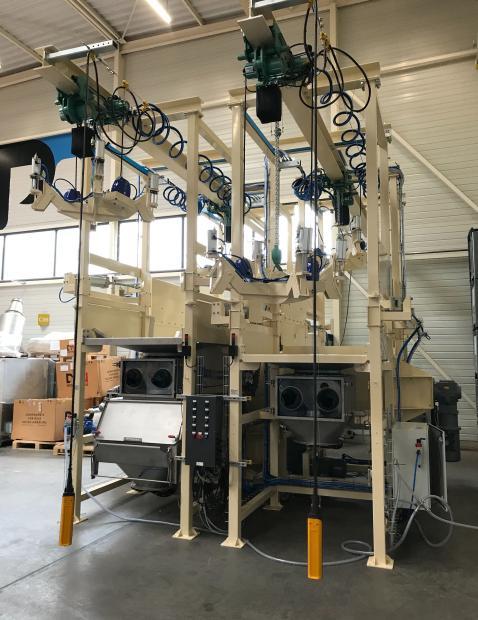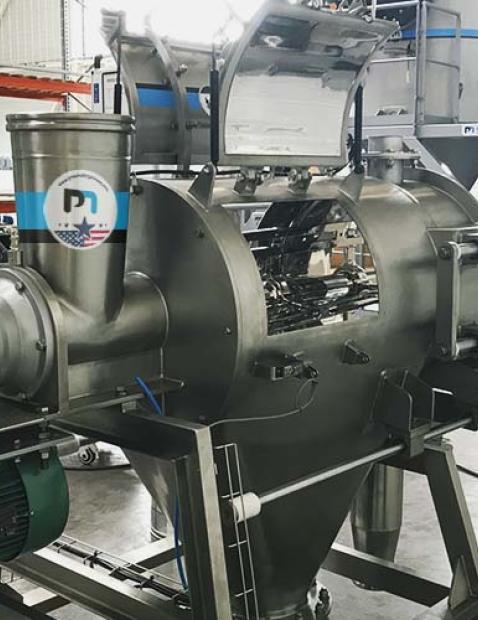- 1. What to do with bulk bags?
- 2. How to choose your bulk bag?
- 3. What is the volume of a bulk bag?
- 4. How do I fill a bulk bag?
- 5. How to unload a bulk bag?
- 6. How to lift a bulk bag / FIBC?
- 7. How to transport a bulk bag?
- 8. How to store a bulk bag?
- 9. How do I keep a bulk bag open?
- 10. How do I open a bulk bag?
- 11. How do I close a bulk bag?
- 12. How to cut a bulk bag?
- 13. How to recycle bulk bags?
The bulk bag, also called FIBC (Flexible Intermediate Bulk Containers), is used in many sectors of industry thanks to its versatility of use and its ability to transport loads heavier than its own weight (up to 2,500 kg). / bulk bag). In order to handle it safely during the bulk bag filling, bulk bag unloading, bulk bag transport and bulk bag storage phases, our bulk bag handling experts can provide you with advice on frequently asked questions such as: how to use a bulk bag, what to do with bulk bags, how to hold a bulk bag, how to move a bulk bag, etc.
1. What to do with bulk bags?
Both resistant and flexible, bulk bags represent an effective solution for handling dry bulk products, powders, granules, rubble as well as for waste disposal. They can be used to transport materials or to store them.
The bulk bag constitutes an effective alternative to the industrial bag during the weighing operation, which can generate pain for production operators with excessively large load ports. Find out in our dedicated article: why switch to a bulk bag?
2. How to choose your bulk bag?
There are several kinds of bulk bags / IBCs. They can be distinguished according to the accumulation of static electricity that they generate (type A bulk bags, type B bulk bags, type C bulk bags, type D bulk bags) but also according to their shape and their main functionality. (U-shaped bulk bag, cubic bulk bag, circular bulk bag, etc.).
Many characteristics must be taken into account when choosing a bulk bag: type of straps, types of linings and coverings, filling and closing skirt, total opening, filling chute, closed flat bottom, emptying chute, open bottom, multiple use or single use…
To find out more, see our dedicated article: How do I choose the type of bulk bag suited to my process?
3. What is the volume of a bulk bag?
The volume of a bulk bag depends on the material inside. Generally, a bulk bag can contain up to 1m³, although smaller capacities like 0.25 or 0.5m³ exist for industries like the pharmaceutical industry.
It is possible to find tailor-made dimensions for certain bulk bags intended for very specific applications.
4. How do I fill a bulk bag?
Before any bulk bag filling operation, make sure you have a bulk bag support, or place the bulk bag on a stable surface. The width / diameter ratio should not exceed 2:1. A vibration device can complete the bulk bag filling process to improve its stability.
It is possible to place the bulk bags directly on the ground or on a pallet. Do not fill a bulk bag unevenly.
Palamatic Process has a wide range of bulk bag filling stations for handling your powders and bulk solids. Find out how to choose your bulk bag filling system.
5. How to unload a bulk bag?
In order to ensure the deconditioning of a bulk bag, several loading modes are possible: electric hoist, forklift and low structure via the use of a crane. A Palamatic bulk bag handling cross can be coupled with this equipment to provide safe handling and easy positioning of the bulk bag.
Bulk bags can be unloaded by a suction device or by gravity. A discharge chute can be used to control the unloading process. In other cases, for bulk bags with a flat bottom, cutting the bottom of the bag that will allow it to be emptied.
In order to facilitate the flow of the product during the bulk bag emptying operation, a vibrating motor or a pneumatic massage system can be set up.
6. How to lift a bulk bag / FIBC?
Before lifting a bulk bag, it is imperative to make sure that all the loops are vertical without being twisted. The fork must not have a sharp edge that could potentially damage the bulk bag or cut the loop.
A bulk bag lifter is ideal for lifting and transporting bulk bags. It allows fast hooking and unhooking of bulk bags. The construction of the lifting beams, in painted steel or stainless steel, minimizes their weight and makes them more robust.

7. How to transport a bulk bag?
A bulk bag is more or less easy to move depending on the number of lifting points it has (1 lifting point, 2 lifting points or 4 lifting points).
Pallet truck (ground handling and transport of bulk bags on pallets), forklift, truck and crane truck (for a large transport capacity ranging from 7 to 8 bulk bags) are all suitable tools for bulk bag handling.
Several safety measures should be taken into consideration when transporting a bulk bag:
- Do not stay under a hanging bulk bag.
- Do not abruptly interrupt the lifting and transport phases of the bulk bag
- Do not move a bulk bag with a handling device with not enough lifting capacity (respect the maximum load indicated)
When a filled bulk bag is transported by forklift, be sure to leave it close to the ground to ensure the stability of the device.
Find out which type of bulk bag is suitable for storing and transporting your bulk products.

If your require further assistance,
I am at your entire disposal.
Tarik, powder expert
8. How to store a bulk bag?
In order to protect and extend the lift of your bulk bag / FIBC, whether empty or full, storage away from heat sources, in a dry and clean place is recommended. Frequent temperature variations should also be avoided.
There are several types of storage of bulk bags depending on the nature of the powder stored: storage on the ground, storage on shelves (with or without pallets), stacking of bulk bags (asking beforehand to study their stability).
Once empty and folded, bulk bags take up very little space.
9. How do I keep a bulk bag open?
To keep the bulk bag open during the filling and storage stages, a bulk bag holder can be used. This support can be adapted to the dimensions of bulk bags, can be fitted with a retention tank and has different types of possible hooks (fixed or adjustable tension).
The transport of the bulk bag support can be done using a forklift or a crane, and in some cases the bulk bag support can have wheels, thus facilitating its movement. Removable support frames for bulk bags can also be used and allow easy flow of materials.
10. How do I open a bulk bag?
There are several ways to open a bulk bag. Depending on the type of loading and / or unloading desired, the selection of the bulk bag opening system will not be the same.
For bulk bag packaging, you will have the choice between the total opening, the skirt, the filler neck or the flap option.
For emptying your bulk bags, you will have to decide between the total opening, the emptying chute or the flat bottom, depending on your industry and the technical specificities of the material handled.
Find out more about the different bulk bag opening systems.
11. How do I close a bulk bag?
To protect the contents of the bulk bag from its external environment (high temperature, humidity, etc.), some bulk bags with a flat bottom and / or discharge chute have a closing skirt (example of circular bulk bags which are re-sealable).
For a tight seal of the bulk bag, an internal bag sealer can be added to the bulk bag filling station.
12. How to cut a bulk bag?
During the bulk bag emptying phase, the bulk bags with a flat bottom will be cut. The solution offered by Palamatic is the bulk bag piercing tip. Two variants exist for this option:
- U-shaped bag breaker tip: particularly used when using a bulk bag with a cuff, this tip allows the bulk bag to be opened without direct intervention by the operator. It cuts open the bulk bag up to her cuff.
- V-shaped bag breaker tip: particularly used for full-bleed bulk bags, this tip also does not require direct action from the production operator. This tip is used to cut open the bottom of the bulk bag.

Vibration tray Handling cross Big bag punching tip
13. How to recycle bulk bags?
Bulk bags can be recycled and repackaged. The bulk bag recycling step requires:
- That the bulk bags are empty and have no more staples
- Folding bulk bags in three
- The construction of stacks of bulk bags
- Storage of bulk bags in an airtight place before taking them to a dedicated collection point.
Palamatic Process offers a bulk bag compactor to help you reduce the volume of your waste.




















